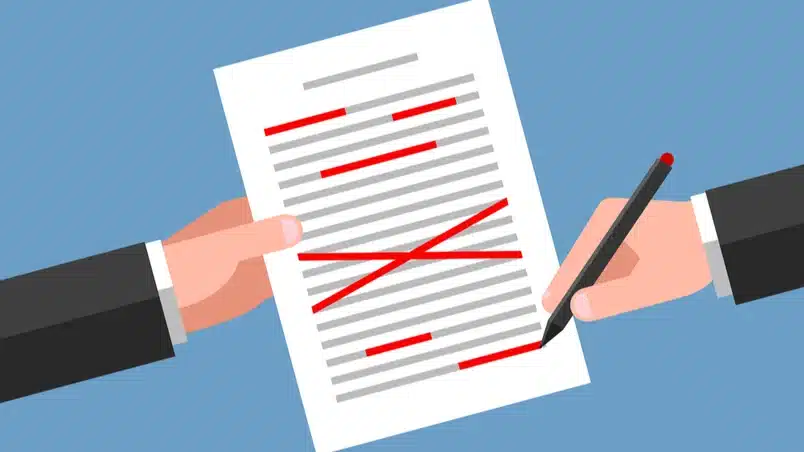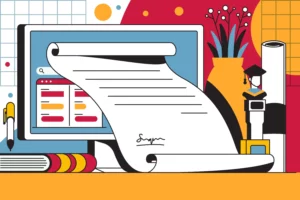Talking about making deals in business, it’s super important to make sure everyone agrees on the rules and what’s being promised before anyone signs anything. But getting to that point isn’t always easy; it can take a lot of back-and-forth and tweaking things here and there. That’s where something called contract redlining or blacklining steps in.
With contract redlining, people can suggest changes or updates to a deal before it’s set in stone. This method lets everyone involved mark up the document with notes on what needs fixing or adjusting so all sides are happy with every detail, including any small tweaks.
Back in the day, this was done by hand using an actual red pen on paper copies of contracts. These days though, thanks to technology like Microsoft Word and Google Docs, this process has gotten way smoother. With these digital tools offering features for automatic tracking of changes made by different folks involved makes seeing who suggested what change—and why—a breeze.
In our chat today we’re going into more details about how crucial contract redlining is when you’re trying to seal a deal without hiccups—especially looking at some challenges that come along with it—and how leveraging modern tech tools from giants like Microsoft and Google can help streamline everything from proposing edits right down signing off confidently.
Understanding Contract Redlining

Getting the hang of redlining contracts is crucial for making sure they’re done right. In simple terms, when you’re redlining a contract, you’re suggesting and talking over changes before the deal is sealed with a signature.
As part of this process, everyone involved works together to point out which parts need to be updated or tweaked so that there’s agreement on any new phrases or small changes needed. This makes negotiating contracts smoother because it helps everyone understand each other better and stops problems before they start.
With digital tools like Microsoft Word and Google Docs, this whole redlining thing has become much easier and faster since these platforms let you keep track of all the edits in one place, letting people quickly go through them and decide what stays or goes.
The Basics of Contract Redlining
Redlining is a key step in the process of negotiating contracts. It’s when everyone involved gets to suggest changes and make sure they’re okay with everything before they agree for good. People use tools like Microsoft Word or Google Docs to mark up the contract with their suggested tweaks.
With redlining, folks work together on the document, pointing out bits that need fixing or updating. This teamwork makes it easier for everyone to get on board with new suggestions, different phrasing, or small fixes here and there. By talking about these edits openly, redlining helps avoid any mix-ups or problems down the line.
Nowadays, there are some really handy tech solutions out there for managing contracts during this stage. These platforms come packed with features like track changes so you can see what’s been altered; version control which keeps tabs on all versions of your document; and secure places online where you can keep your documents safe while everybody reviews them and adds their two cents.
In our next bit, we’ll dive into why redlining is so important when hammering out a deal in negotiations – how it plays a big part in making sure everyone ends up happy with the final agreement.
Importance of Redlining in Contract Negotiations
Redlining is super important when people are trying to agree on a contract. It’s all about making sure everyone understands and agrees with the terms before they finalize anything. With redlining, folks can suggest changes or different ways of saying things in the contract, which helps make everything clear and accurate for everyone involved.
In negotiations, each side might see things differently or want different outcomes. Through redlining, there’s a way to look over the contract together and tweak it so that it reflects what everybody wants and needs accurately.
By going through this process of collaborative editing, any problems can be spotted early on; confusing parts get cleared up ensuring that the agreement works well for all stakeholders involved. This teamwork in editing really helps prevent misunderstandings later down the line.
At its core, redlining is key during these talks because it leads to an agreement that makes everyone happy and lays down a solid base for good business relationships moving forward.
Related Article: Level Up Your Legal Operations: 6 Tips To Legal Efficiency
How to Redline a Contract?

When you’re redlining a contract, it’s like going through a few important steps to make sure everything is spot-on and accurate. Starting off with a plan helps smooth out the whole process and makes working together easier for everyone involved. Let’s dive into how this works step by step.
First up, we take our time looking over the contract carefully. Then, we jot down some initial thoughts or changes in redline form. After that comes chatting with all the stakeholders to get their input and making any needed adjustments based on what they say. In the end, we wrap things up by finalizing those changes in the redlined contract.
Step 1: Reviewing the Contract Thoroughly
To start redlining a contract, the first thing you need to do is go over the whole document very carefully. This means reading it closely and making sure you really get what all the terms and conditions are saying. While doing this, it’s super important to spot any parts that might need some tweaking or changes. Keep an eye out for legal phrases that aren’t clear, sections that could mean more than one thing, and anything else that doesn’t quite fit with what everyone agreed on.
By taking your time to look through the contract well, you’ll understand exactly what it says now and figure out which bits should be marked for redlining. Doing this prep work makes sure when it comes time to suggest changes or negotiate things later on in the redlining process; everything needed has already been pointed out.
Step 2: Making Initial Redline Comments
After you’ve carefully looked over the contract, it’s time to start making some initial redline comments. This means turning on the track changes option in your word processor, like Microsoft Word. With this feature on, you can mark up the contract with notes and suggest edits right there on the document. Make sure to point out any parts that need tweaking by highlighting them and explaining what changes you think should be made.
By kicking things off with these redline comments, everyone involved gets a clear picture of what adjustments are being suggested. The great thing about using track changes is that it makes it super easy for people to spot where modifications have been proposed, see exactly what’s different, and get why those alterations are being recommended. To make these revisions stand out even more, changing the font or color—using something like red ink—is a smart move because it separates your suggestions from the original text of the contract.
This step really helps get everyone on board for working together through negotiating tweaks in the agreement while keeping all parties clued into what’s being proposed.
Step 3: Collaborating with Stakeholders
Working together with everyone involved is key when it comes to the redlining process. Once you’ve added your initial comments, it’s essential to get input from all the important people like lawyers, experts on the subject, and anyone else who has a say in negotiating the contract.
Depending on what works best for communication and which tools are available, this teamwork can look different. It might be through online meetings, sending emails back and forth, or even editing documents together in real-time using platforms such as Google Docs or Microsoft Word with its track changes feature.
In these collaborative sessions, everyone gets a chance to talk about any suggested edits, clear up any questions or concerns they have, and work out details of the contract terms. This way of working together makes sure that communication flows smoothly; everybody understands each other clearly and agrees on how things should be done by reaching a final agreement.
By bringing stakeholders into this part of drafting contracts – known as redlining – you gain access to various viewpoints along with their knowledge and insights which contribute to strengthening your contract.
Step 4: Finalizing the Redlined Contract
The last thing to do in the redlining process is to wrap up the contract with changes everyone agrees on. This means going through it carefully, making sure everything’s right, and getting a final copy ready for signing.
With this step, you’ve got to double-check the contract with all its edits. Make sure every change that was talked about is in there correctly by looking back at your notes or comments so nothing gets missed.
After checking that all edits are good, it’s time to make a clean copy of the contract. This version will have all those agreed-upon changes but won’t show any of those editing marks or comments anymore. It’s this clean document that everybody will sign off on, sealing the deal made during the redlining stage.
So basically, if you follow these steps well when doing redlining work—making sure every edit is spot-on and ending up with a clear final version—you’ll be set for getting things signed without any hitches.
Related Article: Contract Negotiation: Proven Strategies For Collaboration
Who is Responsible for Contract Redlining?

Usually, the job of going through contracts and suggesting changes falls to the legal teams and contract managers inside a company. They have the know-how to check over agreements, offer up revisions, and talk terms.
But depending on what kind of organization it is and how complex the agreement is, other folks like commercial teams or experts in specific subjects might get involved in this redlining process too. At the end of the day, who takes care of redlining really depends on how a company is set up, what risks they’re willing to take on, and what resources they’ve got at hand.
Roles and Responsibilities in the Redlining Process
During the redlining process, a bunch of different people play important parts to make sure negotiations go smoothly and effectively. Usually, it’s up to the legal team or those in charge of contracts to take care of most things when it comes to contract redlining. They’re the ones who know all about laws and are good at checking contracts, suggesting changes, and talking terms.
On top of that, experts on specific topics might get pulled in to help out with certain details in the contract during this redlining thing. And sometimes you’ll see folks from commercial teams jumping in too – especially if there aren’t many lawyers around – because they know their stuff when it comes down to negotiating within their area.
For everything to work out well with the contract redlining process, everyone involved needs to talk clearly and work together closely. By bringing together different skills from various roles like stakeholders have got going for them can really smooth out this whole process making sure nothing is missed ensuring both sides understand each other perfectly.
When to Redline a Contract

Understanding when to redline a contract is key for the negotiation process to be successful. When a contract gets shared with the other party for their thoughts, that’s usually when it gets redlined. At this point, both sides can suggest edits, offer different words, and talk about any issues they might have with what’s being agreed upon.
In the early parts of managing a contract, especially during negotiations, redlining plays an essential role. It lets everyone involved carefully look over all legal and business aspects of the agreement so they can agree on everything before actually signing off on it.
Identifying Opportunities for Redlining
Spotting chances to make edits, known as redlining, is super important when you’re in the middle of negotiating a contract. It’s all about going over the contract with a fine-tooth comb from start to finish. This way, everyone involved can point out parts that might need some tweaking or changes so it fits what they want and needs better.
During these talks, opportunities for redlining pop up as folks suggest new ways to word things, add extra sections, or change bits that are already there. It’s key to work together on this part – trying your best to see eye-to-eye so everyone ends up happy with the deal.
When looking for places where you might want to propose edits, think about how much time you’ve got and what strategy will serve you best. Keep in mind any pressing deadlines for getting the contract done and dusted along with any legal stuff or specific business needs that have got to be included.
Common Challenges in Contract Redlining

When it comes to redlining during the negotiation process, there are a couple of hurdles that can slow things down. For starters, getting past communication barriers is one big challenge. On top of that, dealing with technical issues can also throw a wrench in the works.
Overcoming Communication Barriers
Talking clearly is super important when we’re going through the redlining process of a contract. This means everyone knows what’s being changed and why. But sometimes, it’s tough because things can get misunderstood or mixed up.
To make sure everyone gets it right, setting up good ways to talk to each other helps a lot. Explaining changes well makes sure no one is confused about what’s supposed to happen next. It lets people have real talks about the updates needed.
On top of that, simple mistakes by us humans can mess things up too. These slip-ups can slow everything down during the redlining stage. By using a contract management tool that lets people comment directly or chat with each other, these problems become smaller since everyone can communicate more clearly and quickly with all involved parties like stakeholders.
How can a Contract Management Software help in Contract Redlining?

A CLM software plays a pivotal role in facilitating the contract redlining process, aiding in various stages of the contract lifecycle. Here’s how contract management software can help streamline contract redlining:
- Automated Tracking: Redlining software enables automatic tracking of changes made throughout the contract lifecycle management process, ensuring transparency and accountability.
- Version Control: By maintaining different versions of the contract within a single document, contract management solutions prevent confusion and mitigate the risk of human error during the negotiation stage.
- Collaborative Editing: These platforms facilitate a collaborative process by allowing multiple stakeholders, including legal professionals and counterparties, to review and suggest edits simultaneously, enhancing efficiency and accuracy.
- Workflow Automation: Contract management solutions streamline the contracting process by automating repetitive tasks, such as formatting, clause insertion, and deletions, freeing up time for legal teams to focus on strategic matters.
- Legal Advice Integration: Some contract management software integrates legal advice and expertise directly into the platform, providing users with real-time guidance on potential legal consequences and best practices.
- Electronic Signature Integration: Integration with electronic signature platforms enables seamless execution of contracts, eliminating the need for manual signatures and expediting the contracting process.
- Template Library: Contract management solutions often offer a library of customizable templates, allowing users to create contracts efficiently and ensuring consistency across agreements.
- AI Functionality: Advanced contract management software leverages artificial intelligence (AI) to analyze contracts, identify risks, and recommend optimal contract terms, enhancing decision-making during the redlining process.
- Demo and Training: Many contract management solutions offer demos and training sessions to familiarize users with the platform’s functionality, ensuring a smooth transition and maximizing user adoption.
In summary, contract management software significantly enhances the efficiency and effectiveness of the contract redlining process by streamlining collaboration, automating workflows, integrating legal expertise, and ensuring compliance with legal requirements.
Frequently Asked Questions
What Are the Key Benefits of Contract Redlining?
Redlining a contract comes with some big pluses. For starters, it makes managing the whole lifecycle of a contract smoother. It also speeds up how fast people can agree on things and cuts down on legal troubles later on.
How can I effectively track changes and comments during the redlining process?
In the redlining process, keeping track of changes and comments is super important. With today’s contract management tools, you can use cool features like tracking changes, controlling versions, and making notes right on the document.
What is contract redlining and how does it differ from regular contract editing?
Redlining is when people mark up a contract to suggest changes and tweaks. It’s not like the usual editing of contracts because it includes a negotiation process where everyone involved works together.
Conclusion
To wrap things up, getting really good at the redlining process is key for making sure negotiations go smoothly and everyone agrees. It’s all about knowing the basics, using the right tools, and working well with others to make redlining simpler. Being open and keeping track of changes can make things more efficient and accurate.
Technology also plays a big part in making redlining easier by offering digital ways to deal with usual problems. By putting these methods into practice and taking advantage of technology, you’ll be able to handle redlining confidently and accurately. Remember to always stay informed, flexible, and keep talking to make your efforts in redlining as effective as possible.





